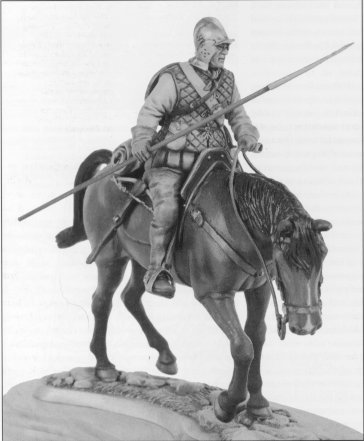The Reiver as a horseman
Aug 24th, 2009 | By admin | Category: Photo History
Figure 1 (Border Miniatures, Keswick)
The one indisputable fact concerning the Border Reivers was their supreme ability in the art of theft and guerilla warfare. A lifestyle which required specialist equipment. The fully equipped Reiver represented an elite light cavalryman, capable of navigating rough terrain at night with practiced stealth, and when required implementing deadly force. Figure 1 (Border Miniatures, Keswick) represents a Border Reiver c. 1590. The mount of the Reiver was as specialised as the equipment they used. It was small and sure footed ideally suited to the rough terrain of the border. Known as ‘hobbys’ or ‘hobblers’ they were capable of traveling around 60 – 80 miles per day (G Fraser, The Steel Bonnets p86). These abilities saw the mounts well suited to both ‘peace time’ raids, and their use as wartime scouts or light cavalry. Horses were extremely important to the Reivers, both for their status and the basic fact that they were vital for raids.
Towards the end of the 16th century there was a change within arms and armour and consequently military thinking. It was the age of gunpowder and the demise of the chivalrous knight in shining armour. This change had been ongoing for some time, and the end of the dominance of the knight had already been highlighted with the longbow. Representing one the most decisive weapons ever used, the longbow in the hands of the humble peasant had long since taken the shine from many a knights armour. This fact is probably one of the reasons for the ‘backwards’ view many had towards guns. A practiced archer was, at the beginning, capable of shooting more arrows with greater accuracy than any gun. At the beginning this wasn’t all that difficult as on the ascendancy of Queen Elizabeth a practiced archer could fire 12 arrows per minute, while the new arquebus could manage 10-12 shots per hour. Naturally by the end of the 16th century this rate had risen to 35-40, but many were still not convinced. Batches of guns sent to the North were of varying quality, with some reports of injuries, while the quality of the gunpowder was also questionable. Early weapons wouldn’t work in the rain and due to their firing technique were useless for mounted cavalry. All of these reasons probably explain the small crossbow hooked onto the saddle as it could be used with some confidence and little worry of losing a limb if it misfired. Though it is worth noting that guns in the form of ‘calivers’, ‘arquebuses’, and dags (heavy hand gun) were beginning to be used throughout the border. This is mainly due to the wheel-lock mechanism which wasn’t affected by the wet weather. A number of wealthy Reivers would in fact carry two pistols as reloading would take too much time, and they were still prone to the occasional misfire.
The Reiver could also be armed with a sword, a dagger and a Border lance. The lance appears to be a very popular weapon of the Reivers. Measuring from 6 to 13 feet long (more likely around 8 foot) the Reiver became highly adapt in its use. The weapon could be used couched, for throwing or for thrusting at a foe. More than any other weapon, the Reiver was acknowledged as the master of the lance.
The role of the Reiver and the coming of the gunpowder age dictated the type of armour that was used. Though there would have been those who could have afforded plate mail, the Reiver by necessity needed the best compromise between protection and weight. In order to cover the miles, it was not practical to wear full armour on a raid. The wealthier Reiver began to wear just back and breast plate. Many others would often be wearing whatever they inherited or occasionally stole. The universal protection worn by the common man is known as the ‘jack’ or ‘jack of plaite’. This item of protection can be seen as the direct result of the gunpowder age and the need for light armour and maneuverability. The jack featured small overlapping iron plates stitched into two or three layers of quilted cloth. Often fronted with another material such as leather, the jack offered the perfect balance between cost, effectiveness and weight. It was often even the choice of the lords whom preferred it against the heavier plate armour. Again this is due to its effectiveness against sword cuts, and the plate armours uselessness against the up-and-coming guns. The Reiver could also wear gloves of steel or leather, some being made in a similar fashion to the jack. Legs as shown below were rarely protected by anything more than knee length riding boots.
The helmets worn by the Reivers ranged from the simple steel cap to the sallet in the 1500’s. These offered good protection but with the added problem of restricted visibility. By the mid-16th century the burgonett (featured in the picture above), a light open helmet began to take over. Offering an unrestricted view, and a solid design occasionally peaked with protected cheek plates with a projecting peak at the back to cover the neck. It also often featured a strengthening strip of metal over the centre with an added lining of leather (presumably for comfort and to cushion any blows). The helmet may also be covered over or ‘blackened’ to protect it from the elements, and possibly to ensure no tell-tale reflections from the moon occur at inopportune moments.
Possibly the most famous head gear of the Reiver was the morion, a style which became fashionable in the 1580’s, featuring a curved brim, comb and occasional ear pieces. The most common design was known as the Spanish morion, but it also appeared as a ‘cabacette’ morion and the most distinctive ‘combed’ morion. Each style was produced to varying standards of quality and decoration.
Thus the Reiver was armed and ready for war or piece. When reading about the Reivers and their deeds it should always be remembered how skilled they were. Anyone who has visited the borders of England and Scotland will realise the skill it must have taken to traverse the bogs and rough terrain at night. Doing this while armed and rescuing some stray sheep (sheep were ever straying) the Reivers were a bread like ne other.

